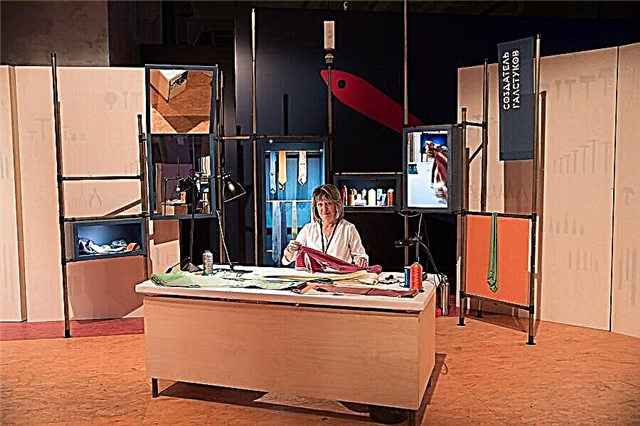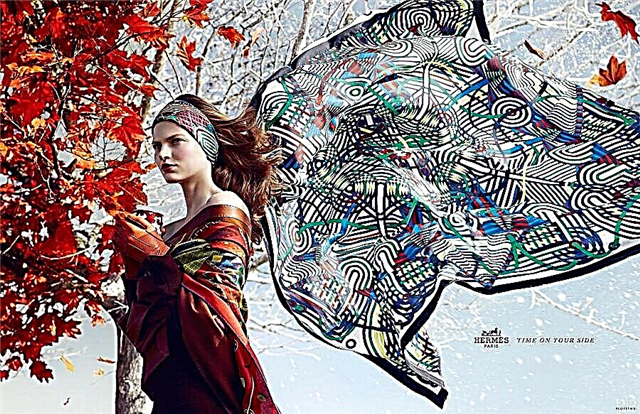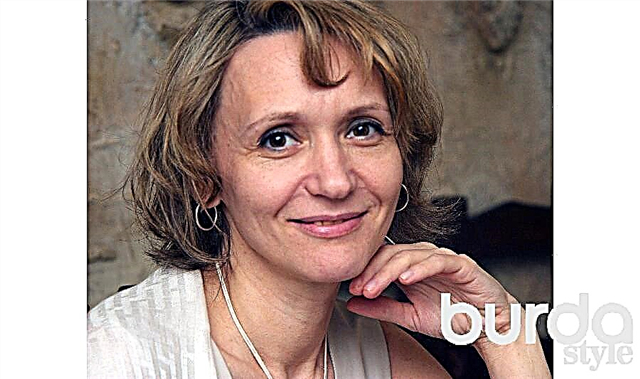What do you primarily remember when you hear the word "Hermès"? Most likely, about silk scarves, and then about bags, or vice versa, but actually Hermès is much more!

This maxim was clearly confirmed by the masters of their craft, representatives of nine different crafts of the great fashion house at the Hermès backstage exhibition, which runs from September 5 to September 14 in the Moscow Museum.

Hermès glover, porcelain artist, saddle-maker, tanner and other professionals demonstrate the creative and technical process, telling the guests of the exhibition about the intricacies of their work.

If you have not attended this truly historic event, you have a few more days to fill the gap!

Handkerchief as a story
A lecture entitled “What does the Hermès scarf tell us about?” Was held as part of the crafts festival, during which Kristin Duvigne, director of the Hermès creative studio, and Dmitry Rybalchenko, artist and designer of the fashion house, helped the guests know and see a little more than what the unprepared look of a casual person sees contemplator - the stories behind Hermès shawls.
How to wear a silk scarf this fall

The history of the Hermès house itself and the history of the artist, the history of travel and the history of remembrance - everything intertwines, blending into a single whole, and already from this alloy, a silk scarf is born.

Since the creation of the Hermès fashion house in 1837, more than 20,000 unique designs have been developed! But in order to fully dissolve in the magic of these shawls, it is necessary to return a little to the past ...
Very first story
The first Hermès scarf appeared in 1937 (100 years after the brand was founded!), Introduced to the general public by Robert Dumas, the son-in-law of Emile-Maurice Ermes, who took over the reins of the brand from his father and grandfather.

The design was called Jeu des Omnibus et Dames Blanches, which means "playing omnibus and white ladies." This watercolor, originally conceived as a board game, once graced a wall in Emil Ermes’s office. What was this game like? New lines of the passenger train, which appeared in the 1820s, with horse-drawn cars surround the central medallion. The players made bets, and then they took out wooden balls from the bag, which determined the winner's number. By the way, the same pattern was presented in several colors at once, which immediately turned into a tradition - an average of ten different color variations are selected for a shawl of one design, from which the most interesting ones are then carefully selected.

About artists and storytellers

Needless to say, the status of the artist Hermès is not a position, but a real title. But despite the fact that the fashion house collaborates with a number of permanent artists, it is also open to all the bold and ambitious: it does not matter who you are or where you come from, if you have a story and you are ready to set it out in a drawing for a scarf, you have chance!

True, it should be borne in mind that there is no shortage of people who want it, and you have very illustrious and worthy artists in role models. One of them, Dmitry Rybalchenko, shared his stories at the craft festival and talked about his favorite Hermès shawls.

I must say, life in a sense predetermined the profession of Dmitry: his grandfather, Vladimir Rybalchenko, came to France several years after the revolution in Russia. His chosen one was the young French aristocrat Alice Ledoux, one of whose three brothers was an artist and worked for Hermès. Despite the fact that Alice's father did not give consent to the marriage, the Russian and French women got married. They had three children - Boris, Vera and Vladimir.Vladimir became a sculptor and artist and also began working for Hermès, as his son, Dmitry, later on. Despite the fact that the biography and even the creative path of Dmitry Rybalchenko is connected with Russia, he does not speak Russian, although he is quite familiar with Russian culture.

According to Dmitry, Hermès often sends his artists on trips to give birth to new designs for shawls. So, for example, a scarf appeared called Sous le Cèdre, "Under the Cedar."

During a business trip to Lebanon, Dmitry conceived a scarf with the symbol of the country, Lebanese cedar. Despite long trips in search of a tree for nature, the search did not lead to anything, since all the trees in the district were battered by diseases and not too careful treatment of locals and tourists. But once Rybalchenko was invited to a villa to one of the local politicians, where, among other things, they demonstrated a magnificent cedar with an age of at least three, or even four thousand years! It was this miracle of the Lebanese flora that became the central motif of the scarf, but the mosaic framing it was not invented, but was taken from nature, from the same villa.

As Dmitry said, the process of creating designs begins with the theme that the leadership of the fashion house sets. Sometimes it is specific, for example, Christmas, sometimes abstract, for example, the birth of an idea. But the rest of the artists do not meet any restrictions in their work and are left with the flight of their imagination. By the way, Dmitry often includes himself and his friends in his drawings! True, to make out them may not be so simple, because often it is only a figure in the crowd or a silhouette in the window.
One of his most beloved shawls of his own authorship, Dmitry calls a work called Cheval Surprise, "An Unexpected Horse." It was this scarf that was created as part of the theme of the birth of an idea.

At first glance, we see only messy blots, monochrome in this case and multi-colored in other design options. But if you look closely, here and there you will begin to distinguish between horses with riders and without. According to Dmitry, he is extremely intriguing and delighted with the ability of our thinking to create new things from the most random things, and this handkerchief perfectly demonstrates how an idea can be born out of small things.

Verily, there will not be enough article, or collection, or even a whole book to contain all the stories of Hermès. A remarkable fact: for all the years the fashion house has existed, a catalog of all the released designs has not been created! An unfortunate omission in which management itself is recognized introduces even more mystery into the brand’s mythology over the decades.

But even if you are not particularly fond of shawls and are completely indifferent to the Hermès style, which is clearly recognizable, despite the amazing variety of artists and designers, even if you accidentally saw a treasured silk square scarf on someone, you can certainly and with complete confidence confirm - This scarf has a story, and he is ready to tell it to anyone who wants to listen.
Photo: Press Service of the Museum of Moscow, Hermès



